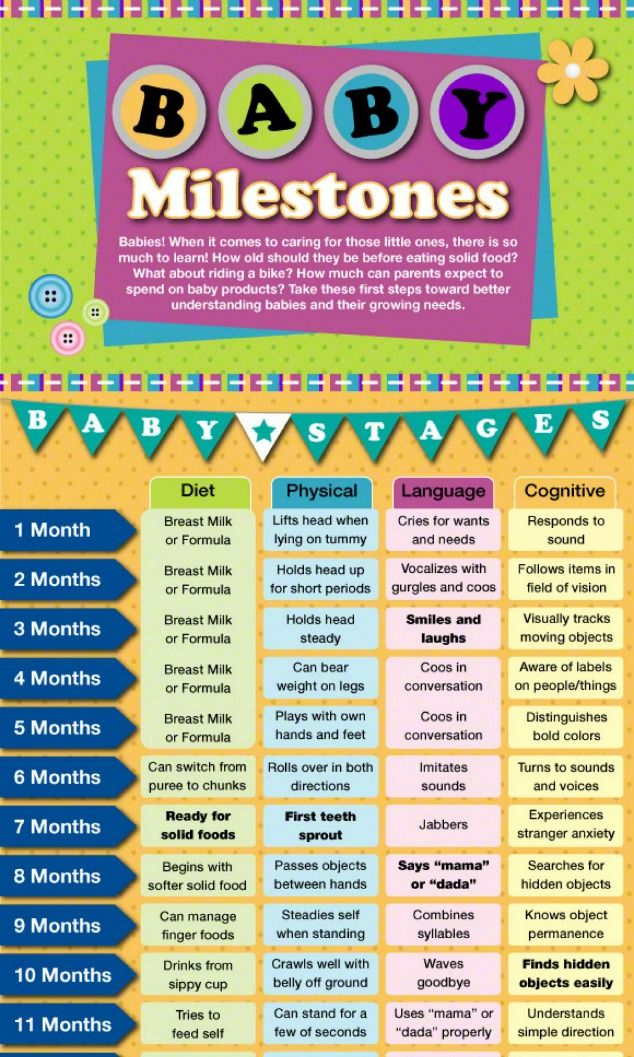9 month old baby gagging on food
Babies Gagging vs. Choking When Starting Solids
Adie, 12 months, gags on a small piece of bread.What is gagging?
Gagging is a natural protective reflex that results in the contraction of the back of the throat to protect us from choking. Just like the reflexive kick that occurs when the doctor taps your knee in just the right spot, the gag happens automatically, initiating a rhythmic bottom-up contraction of your pharynx (the tube that leads to your stomach) to assist in bringing food up and to stop the swallowing reflex from making our bodies try to swallow.
>> Just starting solids? Check out our virtual course (includes videos on infant rescue) as well as our guides and recipes on for the best first foods for baby. And if you are struggling with the transition from spoon feeding / purees to self-feeding with table food, watch our Spoons to Fingers video.
This page has been created with typically developing infants and children in mind. The information here is generalized for a broad audience and is for informational purposes only. If your child has underlying medical or developmental differences, including but not limited to prematurity, developmental delay, hypotonia, airway differences, chromosomal abnormalities, craniofacial anomalies, gastrointestinal differences, cardiopulmonary disease, or neurological differences, we strongly recommend you discuss your child’s feeding plan with the child’s doctor, health care provider or therapy team. The opinions, advice, suggestions and information presented in this article on gagging are for informational purposes only and are not a substitute for professional advice from or consultation with your pediatric medical or health professional. If your child is having a health emergency, please call 911 or your emergency medical resource provider immediately.
Swallowing is a complex reflex with multiple lines of defense built in to prevent choking. These actions happen reflexively, meaning the brainstem tells our body to do them–they are involuntary.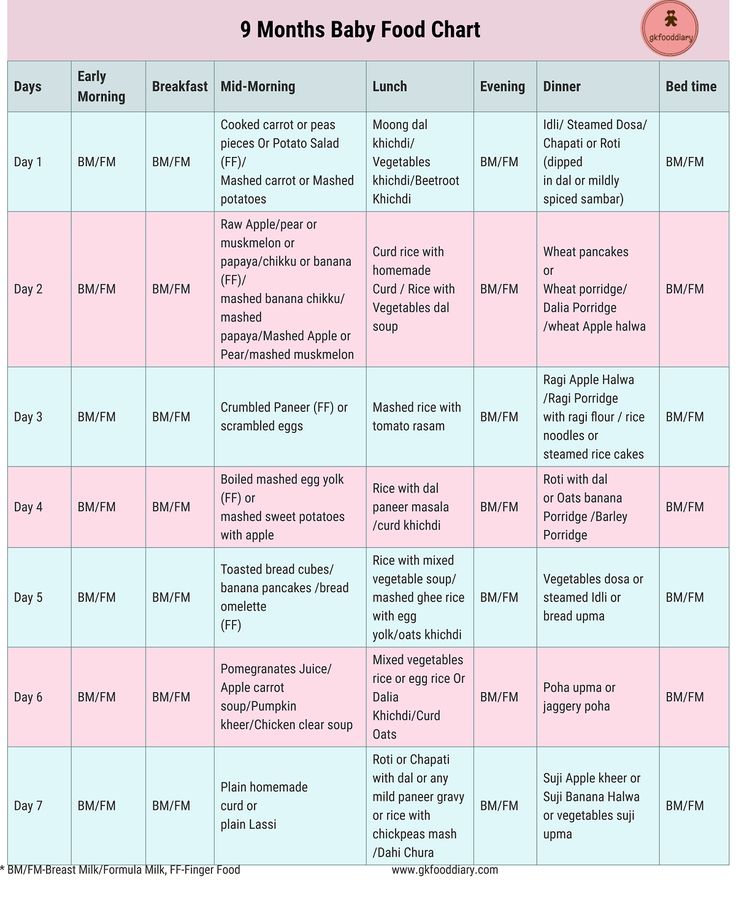 There are three important lines of defense that we have with every single swallow.
There are three important lines of defense that we have with every single swallow.
1. When we swallow, our vocal cords, which are like sliding doors inside the breathing tube, come together, closing off the airway and preventing food from entering the lungs.
2. The muscles of the throat pull the breathing tube slightly up and forward, tucking it safely out of the way of the food passing.
3. The epiglottis, a tiny flap of cartilage, tilts down to cover the airway forming a tight seal with the joints that help move the vocal cords.
Just like any good system, we have back up already built in. We even have back up for those back ups that are activated if needed. For example, if anything gets too close to the opening of the airway, even before it gets a chance to get in, the vocal cords immediately close (the technical name for this is the laryngeal adductor reflex), and our body immediately coughs to push the item away from the breathing tube. Our bodies are quite skilled at keeping us safe.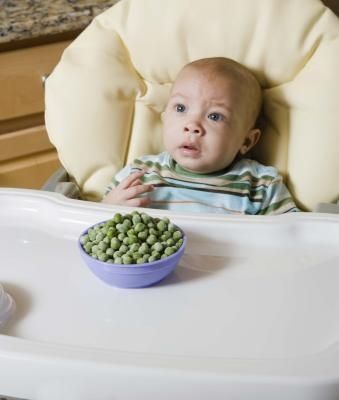 12
12
First, it is important to distinguish the difference between gagging and choking.
True choking is when the airway is obstructed, and the baby is having trouble breathing. Signs of a baby choking can include:
- inability to cry
- difficulty breathing
- skin tugging into the chest
- look of terror
- high-pitched sounds
- skin color changes (ranging from blue to purple to ashen-like)
If you suspect baby is choking, immediately administer infant choking first aid with alternating back blows and chest thrusts and call 9-1-1 or local emergency services on speakerphone so your hands are free. If another person is present, one person should immediately perform choking first aid while the other calls for help. Conduct age-appropriate CPR if you believe baby’s airway is open, but the child is not breathing.
On the other hand, gagging is a common protective reflex that results in the contraction of the back of the throat.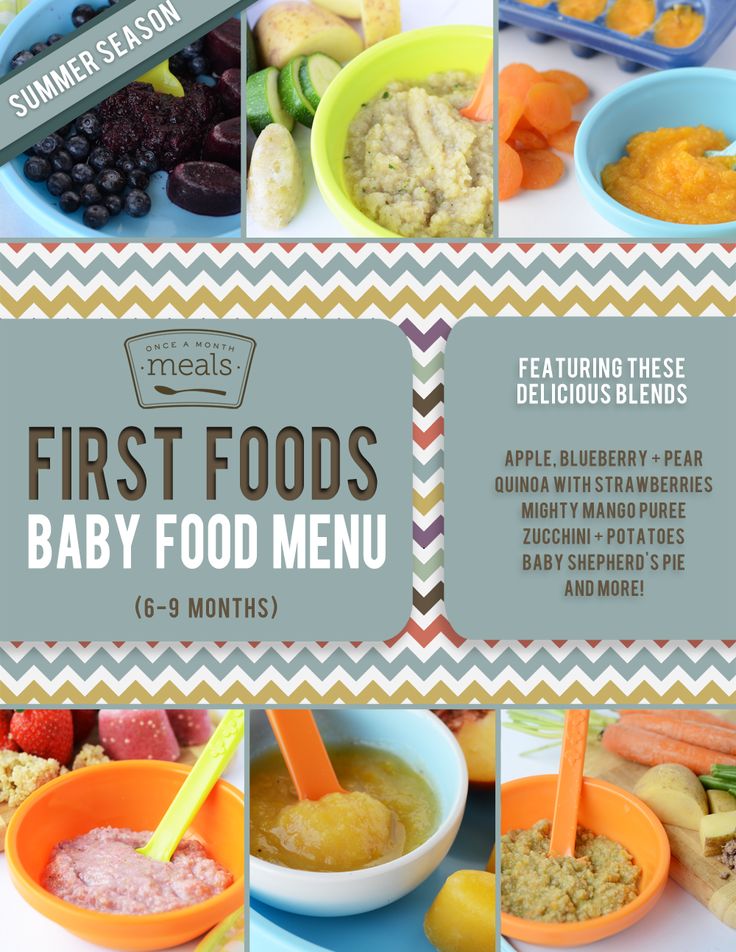 It is a natural function and protects us from choking. When this happens, it’s important to let baby work the food forward on their own. Refrain from sticking your finger in baby’s mouth, which can push the object further down the throat, making the situation worse.
It is a natural function and protects us from choking. When this happens, it’s important to let baby work the food forward on their own. Refrain from sticking your finger in baby’s mouth, which can push the object further down the throat, making the situation worse.
We strongly recommend you take a CPR class online or at your local health facility and review safety procedures. Our choking, gagging & infant rescue video can also help you visualize the difference. Further resources:
- American Red Cross: Child & Baby CPR
- American Heart Association: Infant CPR Training Kits
- Harvard Health: Heimlich Maneuver on an Infant
Gagging is a completely normal reflex in infants, children and adults alike. Gagging is very common and will happen a lot in baby’s solid food journey. All babies gag in their eating journey—it’s one way they learn how to eat. The good news is that babies typically outgrow gagging after a couple of months of practice with various textured foods.
The good news is that babies typically outgrow gagging after a couple of months of practice with various textured foods.
Babies often gag well before they start solids, when breast or bottle feeding. This typically occurs when baby either isn’t properly latched, and the nipple triggers the reflex, or if the baby isn’t ready to swallow milk for whatever reason. Some babies gag when mom’s letdown is too fast. Others gag when they need to catch their breath instead of swallowing. Many babies will gag on a pacifier or certain bottle nipples if they aren’t familiar with them. All of these gags occur because the brain is trying to protect the baby from swallowing an “intruder,” or something the baby isn’t ready to swallow. This gag reflex typically lessens over the first few months of baby’s life when baby gets “desensitized” and learns to accept it (pacifier, nipple, or food texture) without gagging. This occasional gagging at a young age does not seem to bother most infants.
Interestingly, the gag reflex of a 6- to 10-month-old baby is much more sensitive and can be triggered more forward on the tongue than an adult.3 4 This is why babies gag easily: the more forward the gag trigger is on the tongue, the easier it is to trigger.5 It is not uncommon for babies to gag (and occasionally vomit) for the first few weeks of solids. If baby repeatedly gags and vomits past the first month of starting solids, consult your pediatrician, who may refer you to a swallowing specialist.
Watch our video on gagging and all of the other normal, sometimes nerve-wracking things babies do while starting solids.
Cooper, 6 months, gags on applesauce.Ronan, 7 months, gags on a flattened blueberry, spits up some, and carries on eating.Quentin, 8 months, gags and coughs on some bread with avocado. Bread is notorious for triggering gagging as it sticks to saliva on the tongue.Gagging helps prevent chokingWhen the gag reflex is triggered, it forces the back of the throat to close, essentially preventing swallowing. If food caused baby to gag, the reflex forces the food (or object) forward towards the front of the tongue. Young infants naturally open their lips when they gag, which means that typically, the food or object that caused the gag keeps moving out of the mouth.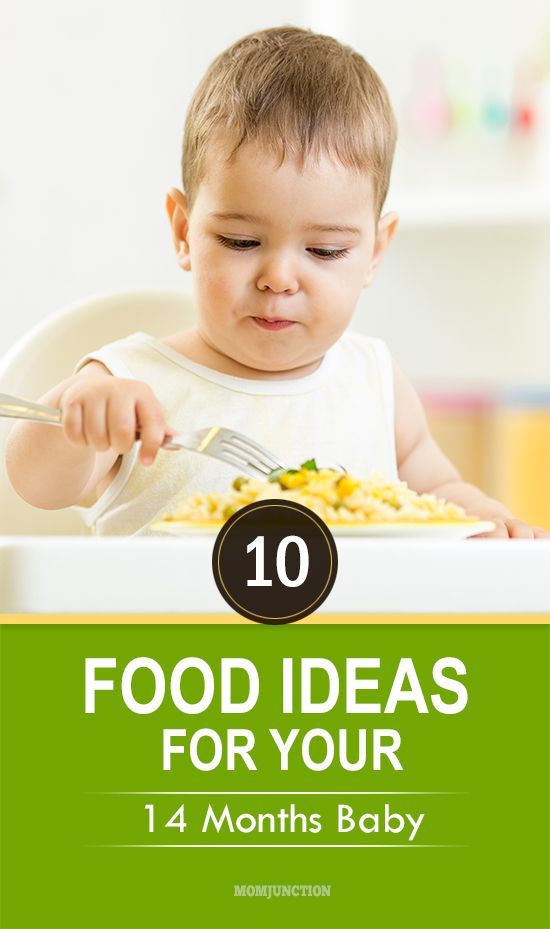
Gagging is completely normal and incredibly important for baby’s safety, both at the table and away from it.
Gagging helps babies learn to eatFor babies to build the skills for chewing and managing all foods (not just easy-to-chew foods), we need to give them opportunities to make mistakes, like taking a too-big bite of food. When a baby bites off too much food and cannot properly move it around to chew, the gag reflex will kick in and help thrust the food forward. The experience teaches baby that the food was too big to swallow. These experiences are essential for learning and building confidence in biting and tearing. Over time, baby will learn to take smaller bites and become more adept at moving food around to chew properly.
Once baby is a few weeks into their solid food journey, you can use the gag reflex to your advantage. Offer foods that are not as easy to chew to help advance baby’s oral development more quickly. When poorly chewed food touches the tongue, the gag reflex will do its job, and baby will learn they need to chew the food more.
It’s important to challenge baby before they get too accustomed to mashes and soft foods. Babies quickly learn that chewing and swallowing mashes and other easy-to-chew foods easily satisfies their hunger with minimal work. Many babies won’t bother trying to improve their skills with tough consistencies that require more biting and tearing, and may refuse the challenging foods and wait for the easier foods.
Hillis, 6 months, gags on a vegetable purée.Addie, 9 months, gags and coughs on asparagus and successfully moves it forward out of her mouth.Ysabella, 8 months, gags on purple dragon fruitWhy is my baby gagging? Gagging is easily triggeredWhen it comes to young babies, the gag reflex is pretty easy to trigger. Touch the middle of the tongue, and many babies will gag. If you watch a 3- to 4-month-old baby mouthing their hands and fingers, you will see them gagging themselves frequently. This is common and normal. Babies are typically not bothered by it and will often keep doing it.
Our mouths are one of the most sensitive parts of our bodies. The human mouth has many sensory receptors to detect touch, taste, temperature, pressure, and other input types. Babies are driven to explore with their mouths to learn about their world simply because the mouth is sensitive. Mouthing exploration could be very unsafe if babies didn’t have gagging as a natural safety net.
Importantly, young infants have immature hand and finger coordination, which means they can’t easily remove something they put in their mouth. They also have immature oral motor (tongue and mouth) coordination. They can’t easily use their tongue to find an object in their mouth and spit it out. This is another reason the gag reflex is a safety reflex, as it allows a baby to put an object in their mouth and then push it back out again without letting it get close to the throat. As babies put things in their mouth, the gag reflex tells them when things are not supposed to be there and prevents it from moving too far back towards the throat.
The gag reflex moves further back in the mouth as babies ageFrom birth to around 7-9 months, the gag reflex is triggered close to the front of the mouth (around the middle of the tongue). At this age, the gag reflex is as sensitive as it will ever be.6 This is important for safety because objects (food or anything else) will quickly trigger the gag reflex and be pushed out of the mouth before they get past the middle of the tongue.
Sometime around 7-12 months of age, the gag reflex slowly desensitizes. The gag trigger moves from the middle of the tongue to the back of the tongue towards the throat.7 At this point, food or objects can get much closer to the throat before the body recognizes something is too big to swallow and tries to push it back out. This might sound scary, but remember, our bodies are amazing! The gag reflex remains active and strong, so if something (food, barbie shoe, bug, etc.) hits the back of the tongue, the back of the palate (roof of the mouth), or even the back of the throat, the gag still kicks in.
Mahalia, 10 months, gags on some orange stuck to her tongue. If you look closely, you can see the orange isn’t actually all that far back in her mouth, but more on the middle of her tongue.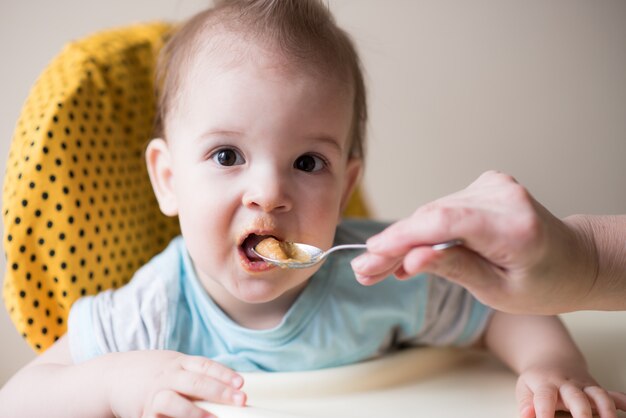 She recovers nicely and carries on eating.Adie, 12 months, gags and coughs on a piece of bread. Bread sticks to the saliva on our tongues easily and can trigger the gag reflex a lot. As you see here, Adie recovers nicely and carries on eating.Babies gag on puréed food and jarred baby food, too
She recovers nicely and carries on eating.Adie, 12 months, gags and coughs on a piece of bread. Bread sticks to the saliva on our tongues easily and can trigger the gag reflex a lot. As you see here, Adie recovers nicely and carries on eating.Babies gag on puréed food and jarred baby food, tooThe threshold for what triggers a gag and the gag’s intensity is different in every baby, but most infants will go through a period where anything in their mouth thicker than breast milk or formula will cause a gag. The brain says: “Wait, this isn’t right! I shouldn’t swallow this! GAG!” Many will gag with spoon-feeding experiences even with runny, watery bland purées.
Until the special day you decide to start solids, baby hasn’t had to manage anything but a watery-thin, fast-moving liquid.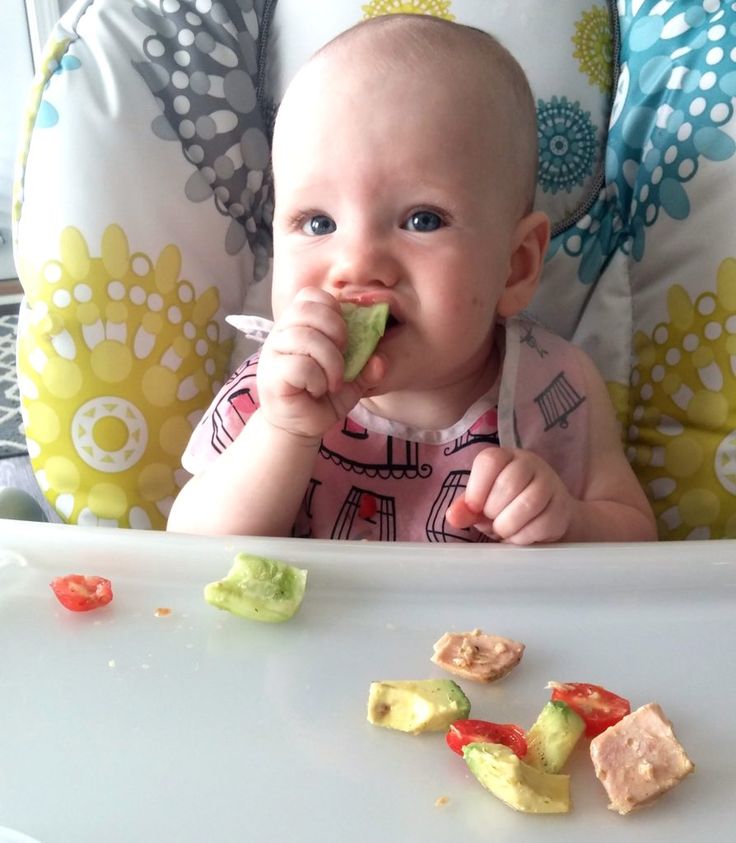 Enter something slightly thicker, slippery, and a different flavor — baby’s brain will kick in with protective mechanisms to gag and prevent swallowing this invading purée. This is usually short-lived because thin purées are quite similar to liquids and the texture won’t trigger a gag for very long.
Enter something slightly thicker, slippery, and a different flavor — baby’s brain will kick in with protective mechanisms to gag and prevent swallowing this invading purée. This is usually short-lived because thin purées are quite similar to liquids and the texture won’t trigger a gag for very long.
Babies know to push the tongue against a breast or bottle nipple to initiate suction and move the liquid backward to their throat. Spoon-feeding can present unique oral-motor challenges. With a spoonful of purée dropped on the middle of the tongue, baby has nothing to suck or push against and doesn’t yet know the skills to help move that food backward. Because they can’t move the purée backward quickly, it either continues to sit on the middle of the tongue or will start spreading around the mouth, which can lead to gagging. Many wise babies will suck on the spoon to help them quickly move the purée back to swallow, just like they do from a bottle or breast. Those babies, who now have a way to control the purée, will often easily swallow with minimal or no gagging.
While not all babies who are spoon-fed gag, many do. Not surprisingly, when a baby is exclusively spoon-fed for a prolonged period of time (past 8 months of age, for example), that child may gag more when they start finger foods due to the lack of texture exposure.
Max, 4 months, gags on rice cereal.Levi, 6 months, gags on a vegetable purée. Jai, 6 months old, gags on a squash purée and mom (rightfully) asks her partner not to intervene.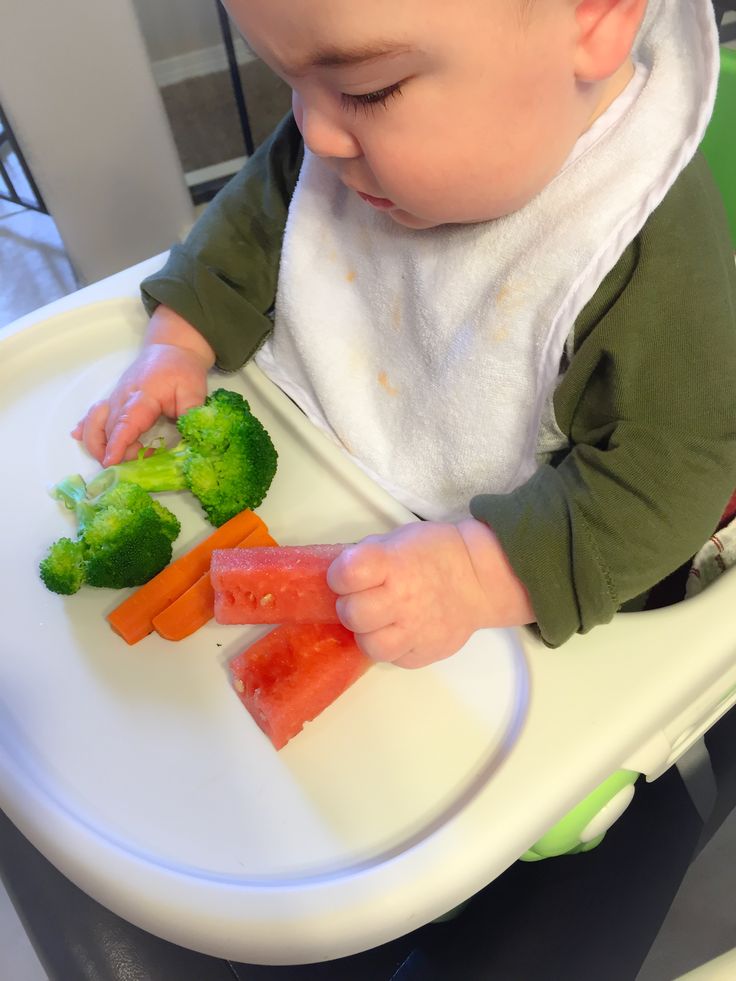 Spoon-fed babies gag less at first but gag more later
Spoon-fed babies gag less at first but gag more laterWhen a baby is started on solids with thin, watery purées and pouches, the baby’s tongue receives less sensory input. While babies gag on purées too, they acclimate to the smooth texture or figure out how to use the spoon to suck back and swallow, which reduces gagging. However, all babies will frequently go through gagging periods when introduced to finger foods — whether 6-month-olds or older spoon-fed babies. When baby is first offered finger foods, the brain engages the safety call: “This doesn’t seem right! I don’t know how to move this! We shouldn’t swallow this food!” Often, this period of gagging will last longer with babies who started with spoon-feeding.8
In 2016, the “BLISS” study found that babies who follow a spoon-feeding approach to solids (spoon feeding smooth purées > lumpy purées > finger foods) tend to gag less at 6 months but more at 8 months and later.9 Remember: around 8 months, a baby’s gag reflex becomes less sensitive and moves further in the back of the mouth.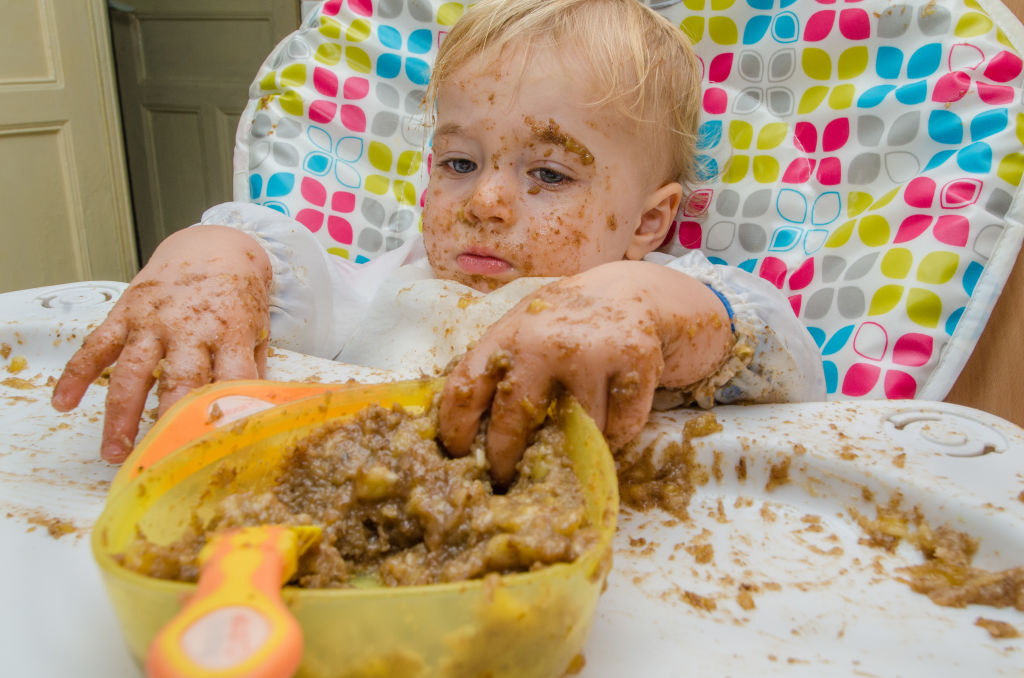 This means that food is closer to the throat before the body reacts and tries to push it out.10 In other words, waiting to introduce finger foods until after baby is 8 or 9 months old may increase the choking risk as the gag reflex is less sensitive, further back in the mouth, and baby is not accustomed to textures other than soft foods from a spoon.
This means that food is closer to the throat before the body reacts and tries to push it out.10 In other words, waiting to introduce finger foods until after baby is 8 or 9 months old may increase the choking risk as the gag reflex is less sensitive, further back in the mouth, and baby is not accustomed to textures other than soft foods from a spoon.
By 8-9 months old, a spoon-fed baby has been practicing a very specific skill to eat. “Purées come into my mouth. I suck or lift my tongue to move that puréed food backward, and I swallow it.” Babies will always start with the skill they know and try to use that same pattern on solid foods. They try to move that solid food straight back without the necessary step of moving the food laterally to their gums to chew. This motor pattern often leads to even more gagging.
The older the baby, the more aware they are of gagging and its unpleasantness. A 9-month-old baby is more aware of gagging than a 6-month-old baby.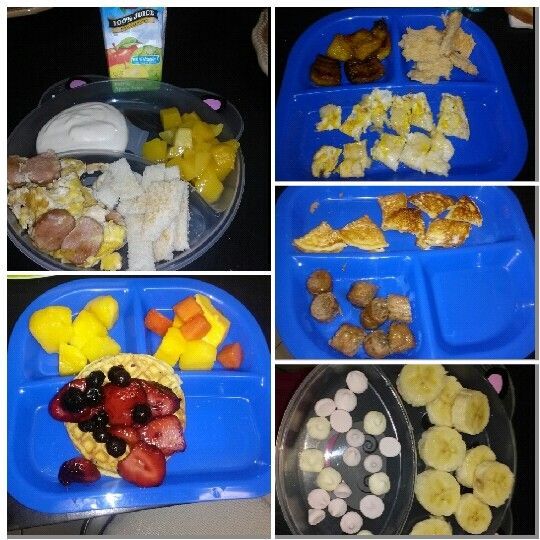 “Hebbian plasticity”—a fancy term that brain specialists use—tells us that neurons that fire together wire together. This means that when one part of the brain lights up simultaneously as another part of the brain, the brain starts to build a connection between those two areas. So, frequently gagging as the baby gets older and more aware of their body may be problematic for some babies who seem to draw a connection between real food and gagging. These babies seem to learn quickly that real food will make them gag and can lead to refusal of any food that is not a purée or mash. By contrast, younger infants don’t seem affected as much as older babies and toddlers.
“Hebbian plasticity”—a fancy term that brain specialists use—tells us that neurons that fire together wire together. This means that when one part of the brain lights up simultaneously as another part of the brain, the brain starts to build a connection between those two areas. So, frequently gagging as the baby gets older and more aware of their body may be problematic for some babies who seem to draw a connection between real food and gagging. These babies seem to learn quickly that real food will make them gag and can lead to refusal of any food that is not a purée or mash. By contrast, younger infants don’t seem affected as much as older babies and toddlers.
At 6 months old, the gag reflex is necessary to exploring food. It’s what allows a young baby with almost zero chewing skills to put a piece of food in their mouth and, if it is too big to swallow, get that food safely back out.
Infants learn how to do amazing things—sitting, crawling, walking, and running—by using reflexes, fumbling around, and making lots of mistakes while slowly building strength and adding one movement on top of another. The same applies when learning to chew—babies use reflexes coupled with fumbling as they learn.
The same applies when learning to chew—babies use reflexes coupled with fumbling as they learn.
Amazingly, babies have two other key reflexes—the biting reflex and the tongue lateralization reflex— which help them learn to chew right away at 6 months. For foods to be properly chewed, baby needs to:
- Take a bite.
- Move that food to the side (tongue lateralization).
- Munch up and down to break down the food down.
- Move the food back to the tongue for swallowing.
When babies first start finger food, they will struggle to use their biting and lateralization reflexes in any coordinated way. Simply put, they fumble around! As babies learn to eat, they won’t break down food enough to safely swallow, which requires the gag reflex to push the unchewed food back out. But every time baby does that, they are learning where the food is in their mouth. Slowly and incrementally, babies learn how to move food to different parts of their mouth. They learn their tongue can help push food around the mouth in lots of directions. They learn their palate, tongue, gums, and saliva will break the food down as it moves around their mouth. All of these actions turn a solid food into something like a mash!
Some experts suggest that purees teach babies to swallow correctly, and gives practice swallowing solids before you introduce the idea of chewing. Most babies do not need to be taught how to swallow. Swallowing is a deep brainstem reflex present by 15 weeks gestation2 and well established by full term birth. Babies already know how to swallow; there is no need to practice! Interestingly enough, thicker textures are actually easier for babies to swallow (think purees), and our feeding therapists explain that babies who have swallowing difficulty are actually prescribed thickened milk to drink! But purees do teach baby a motor pattern: bring food in, move it back, swallow. This is a dangerous pattern because most solid foods require chewing before you move them back and can safely swallow.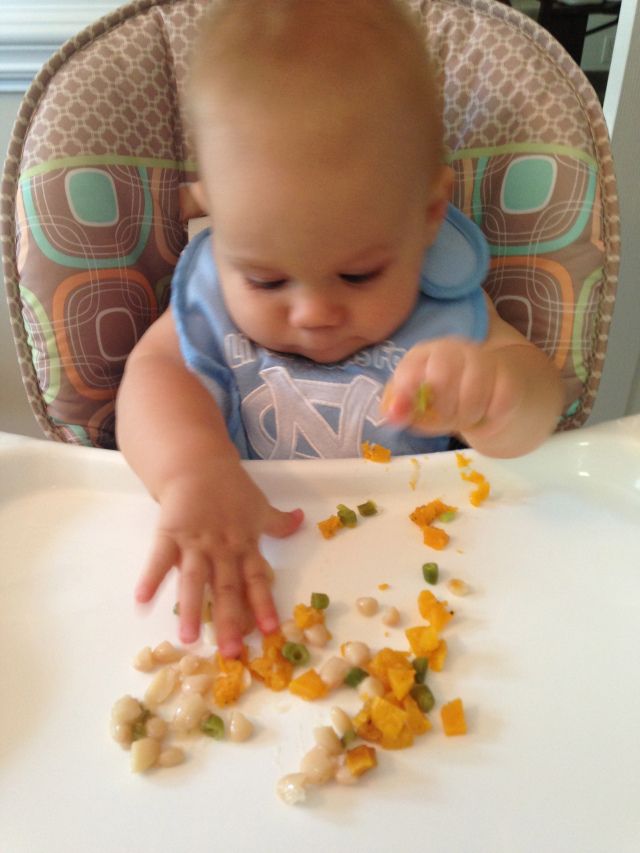 We believe that exclusive purees are time wasted because baby isn’t practicing chewing and is practicing a dangerous motor pattern that must be unlearned.
We believe that exclusive purees are time wasted because baby isn’t practicing chewing and is practicing a dangerous motor pattern that must be unlearned.
Interestingly, the BLISS study also demonstrated that infants who started solids with finger foods experienced more gagging at 6 months, but less gagging at 8-9 months as they developed more control and coordination in moving food around their mouth.11 This demonstrates that babies who are given the opportunity to work with finger foods early on in their solids journey—well before 8 months of age—develop the oral-motor skills required for mature eating more quickly than spoon-fed babies.
After a couple of months, most babies who start with finger foods at 6 months of age develop the skill and coordination to chew and move well-chewed food backward to swallow safely. The baby feels comfortable with their skills and is accustomed to food moving in this way. The body won’t initiate a gag so readily.
By contrast, babies who start solids with purées have had little chewing practice from 6-8 months.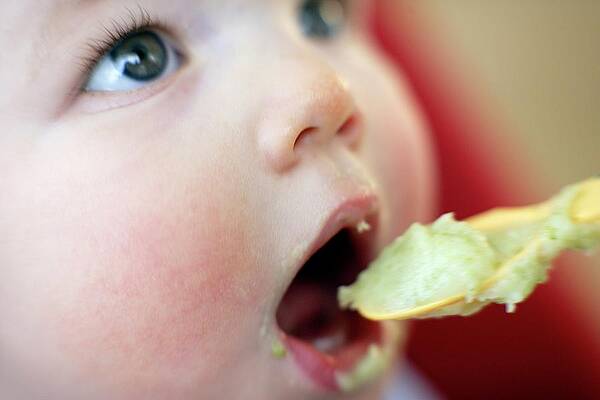 It’s likely they are less coordinated with moving food around their mouth, less able to break down the food, and less safe in the instance that the food gets pushed back further in the mouth than they can handle.
It’s likely they are less coordinated with moving food around their mouth, less able to break down the food, and less safe in the instance that the food gets pushed back further in the mouth than they can handle.
 How to help baby move past gagging by building skill
How to help baby move past gagging by building skillSuccessful eating is not just about chewing but about feeling where the food is in the mouth and knowing if it’s chewed “enough” to swallow safely. As adults, most of us can identify and discretely spit out a tiny piece of bone or eggshell from a bite of food. Because this is happening inside the mouth, we aren’t using our eyes; our brains visualize what’s going on inside our mouth, even though we don’t frequently see what’s going on in there. We have a mental image of our mouth and where everything is in relation to other parts. Babies don’t have this “mental map” of their mouth at first.
To help you understand the necessity of a mental map, think about babies learning to stand. Before they can do this, they need to develop “body awareness” or, essentially, a mental “map” of where all their body parts are in relation to each other. Baby lays on the floor and slowly learns to roll around before they ever sit up. Rolling and touching their whole body—from head to toe—while their muscles push and pull helps form the mental “map” of their body. They need deep input all over their body to add all the details to that map. A small touch to one part of their body or a light brush of your hand over their body helps a little but isn’t really enough. It’s the floor’s firm input to the whole body while moving the muscles that really seems to form a clear map.
Rolling and touching their whole body—from head to toe—while their muscles push and pull helps form the mental “map” of their body. They need deep input all over their body to add all the details to that map. A small touch to one part of their body or a light brush of your hand over their body helps a little but isn’t really enough. It’s the floor’s firm input to the whole body while moving the muscles that really seems to form a clear map.
The same goes for the inside the mouth. When things touch the inside of our mouth, a map slowly “draws” in our brain. As babies develops the map inside their mouth, they gain more control, figuring out how to move food around appropriately. They also become more confident in their skill to move food around. This control seems to help quiet the gag response and move it further back in the mouth over time. The baby does not need the gag reflex to eat once they have a clear map and strong coordination. They now have active control to chew the food, know if it’s chewed enough, move it back to swallow, or spit it out and try again.
We know that many types of sensory input in the mouth help babies form the “mental map,” but that bigger inputs are more effective than light sensory inputs. (Think about the difference between a tight hug versus a tickle on the shoulder.)
There are two types of input that feeding therapists know are most effective for sensory-motor learning:
- Touch or tactile input – when food touches a part or many parts of the mouth
- Messages from the muscles and joints or proprioceptive input – when the mouth gnaws on firm or resistive foods that don’t break when chewing.
The simultaneous combination of tactile and proprioceptive input is most effective for forming the map. This is why feeding therapists frequently recommend giving resistive, flavorful foods like a rib bone for baby to chew.
Foods like a rib bone accomplish the trifecta:
- Baby can hold the food, easily put it in their mouth, and pull it back out with their hands, which gives them control to keep the food at the front of their mouth even if they don’t have oral motor control.

- Baby gets big input to their mouth (touch input and muscle feedback as they bite on the bone), which maps the mouth and leads to better control in the future.
- Baby triggers two key reflexes (biting reflex and the tongue lateralization reflex), which mimic chewing and help baby build strength and coordination for future eating.
Are these experiences for eating? No. These are “exercises” to help build a stronger connection between the mouth and the brain. Drawing a detailed map of the mouth contributes to decreasing the sensitivity of the gag. As this map develops, the baby also develops more confidence in their skill, further decreasing the gag’s sensitivity.
Zuri, 9 months, munches on a mango pit. Mango pits are fantastic for working oral-motor skills and low risk as babies cannot bite through them.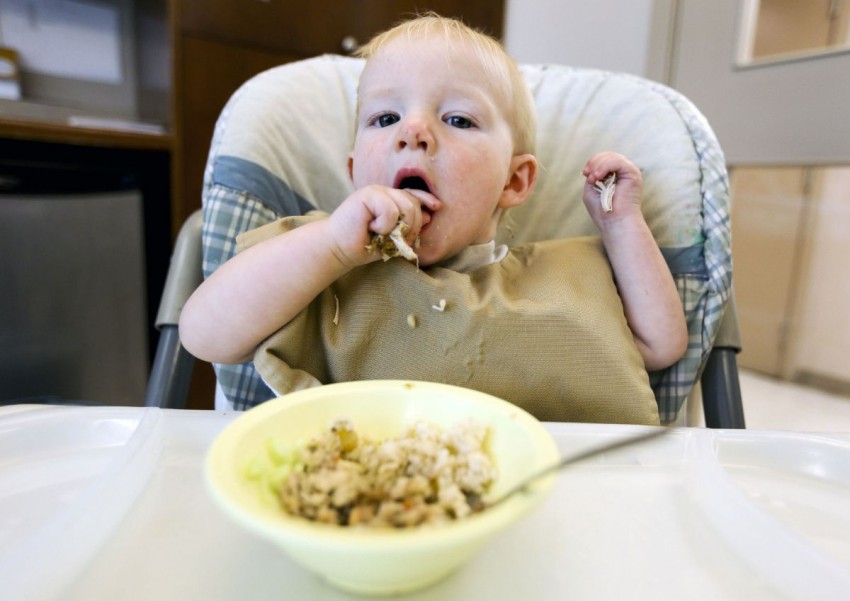 Quentin, 11 months, works on a spare rib. Spare ribs and even just the bone itself without any meat on it are terrific for helping to map the mouth.Amelia, 10 months, works on a chicken drumstick. For information on how to safely introduce drumsticks, see our Chicken page.Kary Rappaport, a Solid Starts feeding therapist, coaches Reza, 7 months, through a gag on a roasted beet.
Quentin, 11 months, works on a spare rib. Spare ribs and even just the bone itself without any meat on it are terrific for helping to map the mouth.Amelia, 10 months, works on a chicken drumstick. For information on how to safely introduce drumsticks, see our Chicken page.Kary Rappaport, a Solid Starts feeding therapist, coaches Reza, 7 months, through a gag on a roasted beet.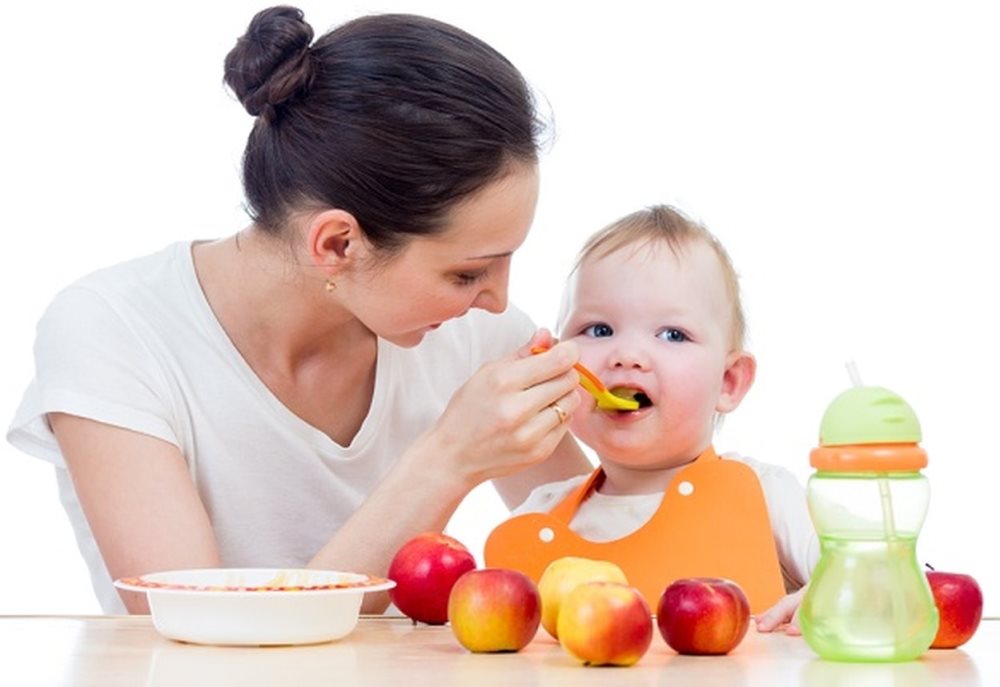 Baby gagging on food and throwing up
Baby gagging on food and throwing upGagging with vomit is so hard to watch, though it is pretty normal for some babies just starting solids. Some babies have a stronger or more sensitive gag reflex than others, bringing food up when they gag. This is even more common in babies with a history of reflux. To minimize this reaction, consider these three things:
1. Make sure your baby has at least an hour between a milk feed and table food to let the stomach digest a bit. A super full belly can make a gag turn into vomit much more easily. For example, we often see vomiting with gagging at breakfast, as the belly is super full from a big morning breast/chest feed or bottle.
2. Avoid the foods that tend to trigger the biggest gags for a while. Often, foods that produce lots of gagging are soft, mushy semi-solids like banana and avocado, or fruits and vegetables with skins. These foods can easily stick to the roof of the mouth or tongue and cause strong gagging that leads to throwing up (which often clears the food from the mouth).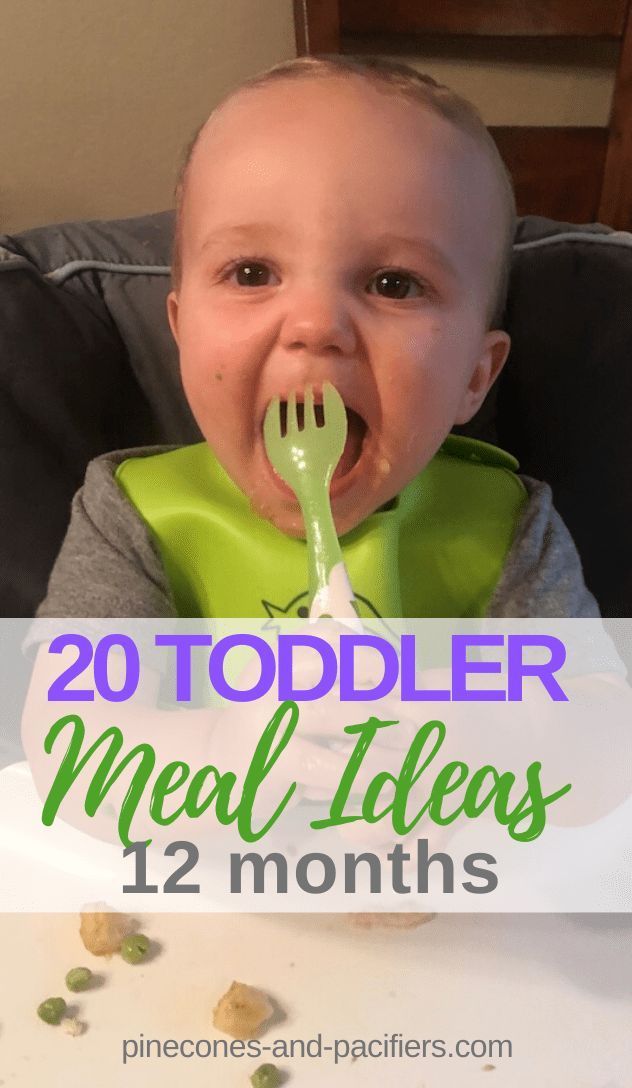
3. Offer tons of opportunities for practice with long, resistive, teether type foods (like a mango pit, a spare rib or other thick rib with all lose bits and gristle removed and most of the meat cut off, or a thick pineapple core that does not taper and won’t easily snap or break apart). These foods aren’t for eating, but for helping the brain learn about and desensitize the inside of the mouth. Gagging is the brain’s way of saying “something isn’t right here,” and mouthing these hard, resistive foods that baby can easily pull back out of the mouth helps the brain learn that food isn’t an “intruder.” Mouthing fingers, toys, and infant spoons as teethers outside of mealtimes can also help dampen that gag reflex a bit.
If you try these tips and your baby continues to forcefully gag and vomit at most meals, you may want to mention it to your child’s medical provider.
When to seek helpWe recommend you speak with your child’s pediatrician regarding a referral to a feeding therapist if:
- Baby continues to gag at most meals after an initial learning period (one to two months of finger foods).

- Baby is frequently becoming upset after gagging (crying, tantrums, vomiting).
- Baby is vomiting at most meals, even on an empty stomach.
While it can be disturbing—and nerve-wracking to watch—gagging is a completely normal reflex in infants, children, and adults. Bottom line:
- Babies will likely gag when they first start solids, regardless of starting on purées or finger food.
- Babies who are spoon-fed thin purées are likely to gag less initially but gag more later on when they start finger foods.
- Babies who start with finger foods tend to gag more in the beginning and less later on as their oral-motor skills develop more rapidly.
- All babies gag in their eating journey—it’s one way they learn how to eat. The good news is that babies typically outgrow gagging after a couple of months of practice with various textured finger foods.
Infant CPR & First Aid Resources
One of the most important things you can do to protect baby is take a CPR class online or at your local health facility and review safety procedures. Some resources:
Some resources:
- American Red Cross: Child & Baby CPR
- American Heart Association: Infant CPR Training Kits
- MedlinePlus: Choking First Aid for Infants Under 1
Remember, you are responsible for supervising your child’s health care and for evaluating the appropriateness of the information in this article for your child. Only you know your child and how your child will react to foods and feeding procedures. Although the information presented in this article is based on well-documented research by medical and nutritional professionals, it is up to you to review and consider the information and how it will work with your child.
Always seek the advice of your pediatric doctor, nutritionist or health care provider with any questions you may have regarding a medical condition or feeding issue. You should refer to our Terms of Use for further information.
Reviewed by:
K. Rappaport, OTR/L, MS, SCFES, IBCLC
K. Grenawitzke, OTD, OTR/L, SCFES, IBCLC, CNT
- Matsuo K, Palmer JB.
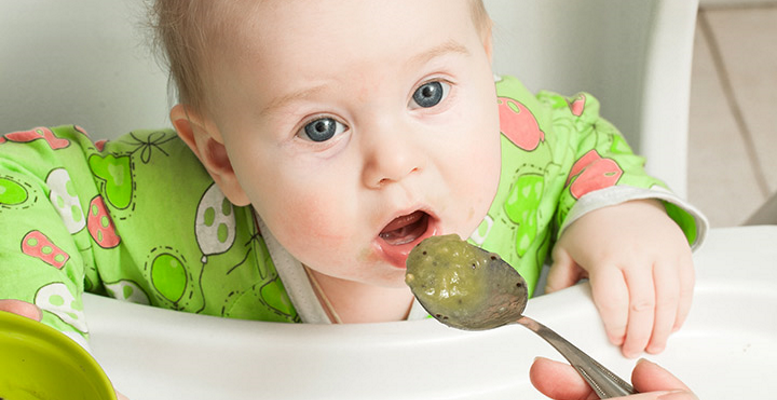 Anatomy and physiology of feeding and swallowing: normal and abnormal. Phys Med Rehabil Clin N Am. 2008 Nov;19(4):691-707, vii.
Anatomy and physiology of feeding and swallowing: normal and abnormal. Phys Med Rehabil Clin N Am. 2008 Nov;19(4):691-707, vii. - Nishino T. The swallowing reflex and its significance as an airway defensive reflex. Front Physiol. 2012;3:489.
- Rapley, G., & Murkett, T. (2010). Baby-Led Weaning. The Essential Guide to Introducing Solid Foods.
- Naylor, A. J., & Marrow, A. L. (2001). Infant Oral Motor Development in Relation to the Duration of Exclusive Breastfeeding. Developmental Readiness of Normal Full Term Infants to Progress from Exclusive Breastfeeding to the Introduction of Complementary Foods, 21–25.
- Isaac, N., & Choi, E. (2018). Infant anatomy and physiology for feeding. In S. H. Campbell, J. Lauwers, R., Mannel, & B. Spencer (Eds.), Core curriculum for interdisciplinary lactation care (pp. 37-55). Burlington, MA: Jones & Bartlett Learning.
- Naylor, A. J., & Marrow, A. L. (2001). Infant Oral Motor Development in Relation to the Duration of Exclusive Breastfeeding.
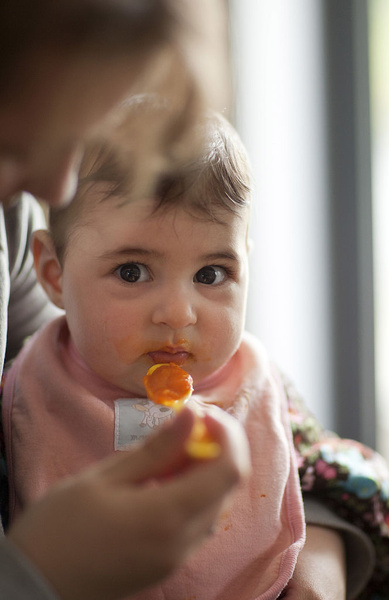 Developmental Readiness of Normal Full Term Infants to Progress from Exclusive Breastfeeding to the Introduction of Complementary Foods, 21–25.
Developmental Readiness of Normal Full Term Infants to Progress from Exclusive Breastfeeding to the Introduction of Complementary Foods, 21–25. - Naylor, A. J., & Marrow, A. L. (2001). Infant Oral Motor Development in Relation to the Duration of Exclusive Breastfeeding. Developmental Readiness of Normal Full Term Infants to Progress from Exclusive Breastfeeding to the Introduction of Complementary Foods, 21–25.
- Fangupo, L. J., Heath, A.-L. M., Williams, S. M., Erickson Williams, L. W., Morison, B. J., Fleming, E. A., Taylor, B. J., Wheeler, B. J., & Taylor, R. W. (2016). A Baby-Led Approach to Eating Solids and Risk of Choking. PEDIATRICS, 138(4).
- Fangupo, L. J., Heath, A.-L. M., Williams, S. M., Erickson Williams, L. W., Morison, B. J., Fleming, E. A., Taylor, B. J., Wheeler, B. J., & Taylor, R. W. (2016). A Baby-Led Approach to Eating Solids and Risk of Choking. PEDIATRICS, 138(4).
- Naylor, A.
 J., & Marrow, A. L. (2001). Infant Oral Motor Development in Relation to the Duration of Exclusive Breastfeeding. Developmental Readiness of Normal Full Term Infants to Progress from Exclusive Breastfeeding to the Introduction of Complementary Foods, 21–25.
J., & Marrow, A. L. (2001). Infant Oral Motor Development in Relation to the Duration of Exclusive Breastfeeding. Developmental Readiness of Normal Full Term Infants to Progress from Exclusive Breastfeeding to the Introduction of Complementary Foods, 21–25. - Fangupo, L. J., Heath, A.-L. M., Williams, S. M., Erickson Williams, L. W., Morison, B. J., Fleming, E. A., Taylor, B. J., Wheeler, B. J., & Taylor, R. W. (2016). A Baby-Led Approach to Eating Solids and Risk of Choking. PEDIATRICS, 138(4).
8 Big Feeding Red Flags for Babies and Toddlers
Is your baby or toddler gagging on foods all of a sudden? Does your toddler chew food and spit it out? Or, your baby won’t put food in their mouth? Find out what’s normal and what’s not from a pediatric occupational therapist.
One of the most popular reasons parents find their way to Your Kid’s Table is because their baby or toddler isn’t eating baby food, table food, or both.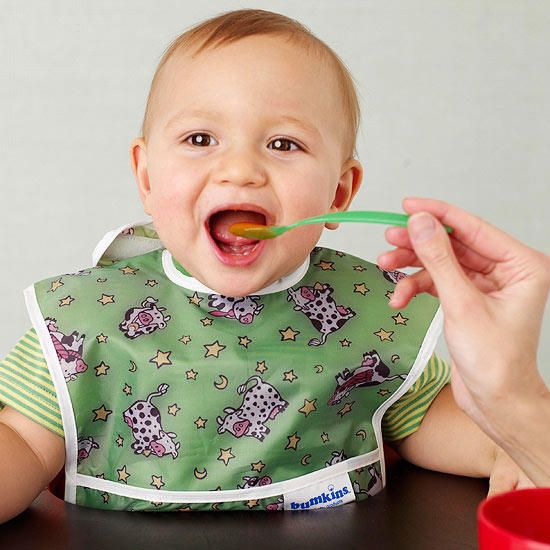 Obviously, this is a huge area of concern for parents. These refusals are usually a red flag that something deeper is going on with their eating, and if it isn’t addressed, it could lead to long years of picky eating and feeding difficulties that causes the whole family stress.
Obviously, this is a huge area of concern for parents. These refusals are usually a red flag that something deeper is going on with their eating, and if it isn’t addressed, it could lead to long years of picky eating and feeding difficulties that causes the whole family stress.
I’ve helped so many families of 2, 4, 6, 8, or even 12 year olds that are in a really desperate spot, and one of the first questions I ask (even for a 12 year old) is, “How did they transition to table foods?”
It gives me a clue as to how eating got so out of control! Because if a baby or toddler gagged a lot or started to all of a sudden, or if they refused to eat, it’s a sign that they have some difficulties that have caused challenging mealtimes for years.
I really want to help parents like you avoid that!
Let’s talk about 8 different feeding red flags for babies and young toddlers and what you can do to help your child.
8 Feeding Red Flags for Babies and Toddlers
#1.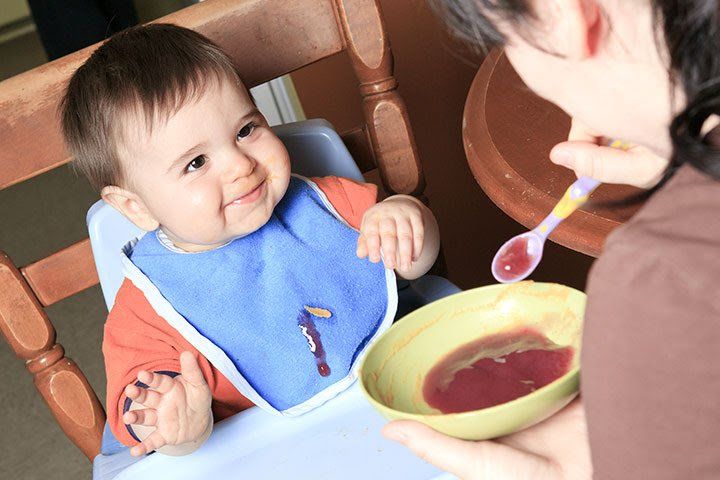 Baby Refuses Baby Food
Baby Refuses Baby Food Not all babies love the mushy pureed stuff, and many don’t gobble it down jar after jar the way other babies do. But, when a baby consistently refuses, and even becomes upset when presented with baby food, it is usually a red flag that there may be some sensory sensitivity.
While babies don’t need to eat baby food and can focus on table foods, it’s important for them to learn to tolerate using a spoon and eat purees like yogurt, soup, and applesauce as they get older.
Head to my baby won’t eat solids to learn a step-by-step plan to help your baby eat pureed baby food!
#2. Baby Refuses Table Food
Often, when babies refuse pureed foods, logically, parents will start trying table foods. In fact, that is just what I would recommend. However, if a baby is refusing pureed foods because of the mushy texture, they also may not be too keen on bananas or avocados.
Or, some babies love baby food, but want nothing to do with table food. There’s a way to help babies and toddlers transition to finger foods.
There’s a way to help babies and toddlers transition to finger foods.
I always recommend starting with a dry and crunchy melt-able like baby puffs. If a baby is steadily refusing those and all other foods, then that is a clear indication that something else is going on.
We have a FREE workshop for parents (you can sign up right now) to learn how to help your baby or toddler eat table foods!
View this post on Instagram
A post shared by Alisha Grogan (@yourkidstable)
#3. Baby or toddler gags at sight, touch, taste of baby food or table food repeatedly
Some gagging when touching or trying new foods is normal, but if your baby or toddler does this every time, then it’s a strong indicator that they are sensitive to different textures. Or, yes, it’s possible your toddler gags at the sight of food alone.
Or, yes, it’s possible your toddler gags at the sight of food alone.
This is because they’re imagining what that texture is going to taste or feel like.
It’s important (and very possible) to work with your child in a slow, but steady pace to help them desensitize to the textures that causing them to gag. Get an entire guide to toddler and baby gagging. You’ll find tips for how to move past it.
#4. Gags, spits food out, or seems to choke repeatedly when trying to chew or swallow food
There’s a difference between gagging when first interacting with a food and gagging when trying to eat.
Gagging or spitting food out after the baby has started eating tends to indicate that a baby may be having difficulty coordinating the actions of chewing and/or swallowing. These are called their oral motor skills.
Some babies and toddlers need help learning to chew. Learn how to help your child with oral motor exercises (free printable included).
#5. Baby or Toddler is only interested in nursing or bottle feeding at 8 months old or later
By 8 months old, at the very latest, babies should be showing some interest in some type of food (puree, soft table foods, or crunchy foods). If they don’t, despite repeated attempts, you would want to consider they have a texture sensitivity, oral motor difficulty, or a possible medical issue like food allergies, silent reflux, or a tongue tie, to name a few.
Make sure you talk to your pediatrician and see a pediatric GI to rule out any physical difficulties you might not be aware of.
#6. Baby or toddler won’t feed themselves with their fingers and/or spoon or fork
Sometimes, children aren’t able to coordinate the action of using a spoon or fork. Of course, I don’t expect a 6 month old to be able to feed themselves much, but they should be attempting to finger feed at a minimum.
When a child at 6, 9, or 14 months old refuses to feed themselves with fingers or utensils, it’s a red flag that they either can’t coordinate the movement required or that they’re too sensitive to textures so they’re avoiding getting messy or having utensils in their mouth.
Either way, you can learn how to teach your child to feed themself.
#7. Only will eat when watching a screen or other distractions
If a young baby or toddler is only able to eat by being distracted by a tablet, TV, phone, or a parent standing on their head trying to entertain them, then they again are lacking the intrinsic motivation to eat, which can happen for a variety of reasons. (See the big 5 reasons babies and toddler’s won’t eat.)
It’s a big bright red flag that something more is going on. Older toddlers and children can fall into this pattern for other reasons, but babies that have never been fed successfully another way, often need help to address the root of the problem.
Again, this is often underlying medical issues, sensory sensitivities, and/or oral motor difficulties.
#8. Doesn’t mouth on toys or chew on found items
I often hear from parents, “I thought it was so great that my baby never put anything in his mouth. ”
”
On the surface, that does seem awesome, but there is a reason babies do that. It desensitizes their mouth to different textures, helps build their jaw, tongue, and lip muscles needed for eating, and they get to practice chewing. If your child never did this and has one of the other red flags, it is likely that there are some underlying difficulties.
Busted Myths About Babies and Toddlers Eating…
Myth #1: My baby isn’t eating because they don’t have teeth
If I had a dollar for every time I heard a parent say their child isn’t eating because they don’t have any teeth yet…. Well, you know how the rest goes! I hear this a lot, and I know that seems like good logic, but I want to shout from the roof tops: Babies and toddlers don’t need teeth to eat successfully.
Really, I’m not kidding!
Think about the first teeth babies get, which is anywhere from 6-14 months old. They are the front teeth. We don’t use our front teeth to chew, and babies shouldn’t be either. Their gums are strong and they should be chewing on them, right where their molars will be. It could be a year later before those molars come in.
Their gums are strong and they should be chewing on them, right where their molars will be. It could be a year later before those molars come in.
Of course, the gums aren’t strong enough to chew steak or raw carrots, that’s why we don’t give those foods to babies.
Otherwise, babies and young toddlers were designed to eat successfully at meals without teeth.
Other foods they shouldn’t eat because they don’t have a teeth and are a choking hazard are:
- nuts
- lettuce
- popcorn
- other tough meats
- most other raw veggies like broccoli, cauliflower, and celery
They need teeth and more advanced chewing skills to manage all of those foods. Other than those tough foods and a few choking hazards like grapes and hotdogs, babies are able to eat a wide variety of foods without teeth.
Myth #2: They will grow out of it
I hear this A LOT too! But, it’s not from the parents of babies that are under 15 months old. It is from the parents of 2, 5, 8 year olds plus.
It is from the parents of 2, 5, 8 year olds plus.
While some parents do arrive at this conclusion on their own because they honestly didn’t know what else to do, sadly, most of the time, parents had a gut feeling something more was going on, but their pediatrician told them, “Don’t worry, she is healthy, she’ll grow out of it.”
I’m not trying to knock pediatrician’s here, they are amazing and I have had the privilege of working with some amazing ones, both personally and professionally. Unfortunately, many receive very little advanced training in feeding difficulties that aren’t causing medical problems or weight loss.
If you see one of these signs, do some research, push for help, or tap into our resources here so you can be supported!
When it’s Time to Get Professional Help
Generally speaking, if your child has two or more of the red flags listed above, I would highly recommend getting a feeding evaluation, which is usually completed by OT’s (like myself) or speech and language pathologists. However, in a lot of cases, only one of these red flags is enough to warrant an evaluation.
However, in a lot of cases, only one of these red flags is enough to warrant an evaluation.
If your baby is not eating any foods by 9 months of age or no table foods by 11 months of age, I would also strongly encourage a feeding evaluation.
More importantly though, if you feel like you don’t know how to help your child and something in your gut is telling you that there’s more going on, then get some help. You will be glad you did.
*Please keep in mind that babies born prematurely or present with developmental disabilities may be on a different timeline. Also, every child is unique and this information is tended to be a guide for parents to make decisions about potential interventions to help their child. If you still aren’t sure if your child needs more help, leave a comment below.
Where to Get Eating Help for Your Baby or Toddler
We specialize in helping babies and toddlers eat well. It’s so important to address it sooner than later because the older a child gets, the more ingrained the challenges become.
We have an online program designed for babies and toddlers struggling to eat table foods called Table Food School and another one for picky eaters called Mealtime Works. Plus, we have two free workshops:
- Click here for a free workshop to help babies and toddlers learn to eat table foods
- Click here to a free workshop to help picky eaters (toddlers and older)
If you’re in the states, you can also look into early intervention. What’s covered varies by state, but the evaluation is often free for kids 0-3 years old. Feeding therapy may also be an option. Check with your individual insurance company first to schedule at a private clinic, outpatient facility, or children’s hospital.
Learn to Eat Table Foods Printable for Babies and Toddlers
Want some concrete tips in your hand right now? I have a free printable that will help give you some direction and ease your worries. It’s for parents that are struggling to get your toddler or baby to eat table foods. I’ll send it right to your inbox:
I’ll send it right to your inbox:
Grab the Free When Babies Won’t Eat Table Foods FAQ Sheet right here!
More on Babies and Toddlers Eating
8 Tips for Nursing Moms Returning to Work With a Baby That Won’t Take A Bottle!
The Best 9 Month Old Baby Food + Table Food Ideas!
How to Teach Your Baby to Chew
Feeding Milestones for Babies and Toddlers
Alisha Grogan is a licensed occupational therapist and founder of Your Kid’s Table. She has over 17 years experience with expertise in sensory processing and feeding development in babies, toddlers, and children. Alisha also has 3 boys of her own at home. Learn more about her here.
Child chokes on food | Mamovediya
Although the reluctance to swallow solid food is a natural response in many situations, and not just those involving food, infants and young children should not constantly choke.
If your child is constantly choking, or the face starts to turn red, or the skin around the lips turns blue, take your child to the doctor.
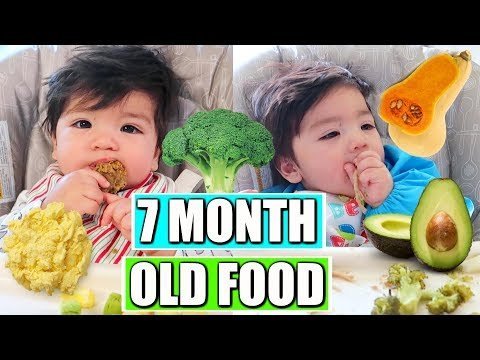 In rare cases, this may indicate a problem requiring medical attention.
In rare cases, this may indicate a problem requiring medical attention. Although your father may be alarmed that you choke on the first spoonful of solid food, this happens quite often when the child starts eating. You have to learn to eat solid food.
In the sucking reflex, babies move their tongue to the front of their mouth and then up to the palate. They make 10 to 20 sucking movements, and then a big gulp follows. With solid food, however, the tongue must almost reverse, sending the food to the back of the mouth.
Learning to swallow solid foods is not easy for an infant. And during the learning process, he may choke if food is directed to his windpipe instead of his stomach.
You can, however, make eating a much easier exercise when the baby does not choke. To do this, you need to master new feeding techniques.
Here are some expert tips.
Wait until the child starts to sit up. If your child is constantly choking on food while eating, it is possible that he has not yet reached the stage of development at which he is ready for this. Your baby must be at least four or five months old before you start solid food.
Your baby must be at least four or five months old before you start solid food.
What is the advice? Give the child solid food when he has already learned to sit more or less confidently. When your child eats while seated, gravity will help guide the food from the mouth into the esophagus.
Start with liquid food . When your baby is really hungry, breastfeed or give him a bottle first to satisfy his appetite a little. If your child is not so desperately hungry, he will be able to handle the difficult task of swallowing solid food more easily.
Eat rice. Rice grains are an ideal first food for children because children are rarely allergic to rice and can be thinned by mixing with plenty of milk.
Your baby will have less difficulty eating porridge if the consistency is more like liquids he is used to swallowing. Once your baby has learned to swallow rice porridge, you can gradually move on to thicker, coarser foods.
Let the first feedings be small .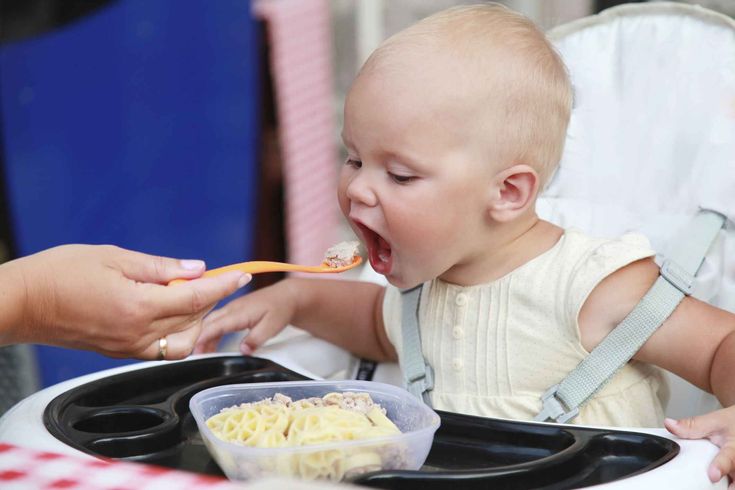 The first solid food feedings are for practice, not real nutrition. An infant who is learning to eat only needs a few tablespoons of solid food a day to practice eating. The main nutrition should come from breast milk or artificial bottle feeding.
The first solid food feedings are for practice, not real nutrition. An infant who is learning to eat only needs a few tablespoons of solid food a day to practice eating. The main nutrition should come from breast milk or artificial bottle feeding.
Start with a small amount of food . When your child opens his mouth, place a pea-sized portion of food on the front of his tongue. A large portion of food will make the whole process of swallowing more difficult for him, and if you put it on the back of the tongue, your child is likely to choke on it.
Do everything calmly, carefully and slowly. Take your time if your child is having difficulty with a new food.
If your child chokes on a particular type of food, such as potatoes or minced meat, pediatricians recommend not eating the food for a few days, then trying it again in a thinner consistency.
Do not overfeed your baby. If your baby vomits or chokes on every feed, it is possible that you are giving him more than he can handle.
In the first year of life, the baby cannot properly control the intake of food, so your task is not to overfeed him.
Watch for signs that the baby is full. He may begin to turn his head away or close his mouth when the spoon comes close to his lips.
What to do if a child chokes
It is impossible to control 100% of all the actions of the baby, therefore, cases when children get something into the respiratory tract or they choke on something often occur. Most often, parents do not need to take any action, because. the child's body is able to independently get rid of a foreign object with the help of a cough. A sign that the airway is not blocked is that the child may cry and/or call for help. Then you just calm the baby and keep the situation under control.
Signs that intervention is needed?
- eyes wide open in panic
- he cannot utter words, cry and scream, or does it quietly and wheezing
- there is increased salivation
- baby opens mouth wide
- skin turns red and then turns blue
- older children may hold their throats
- loss of consciousness
The first thing to do is to call an ambulance.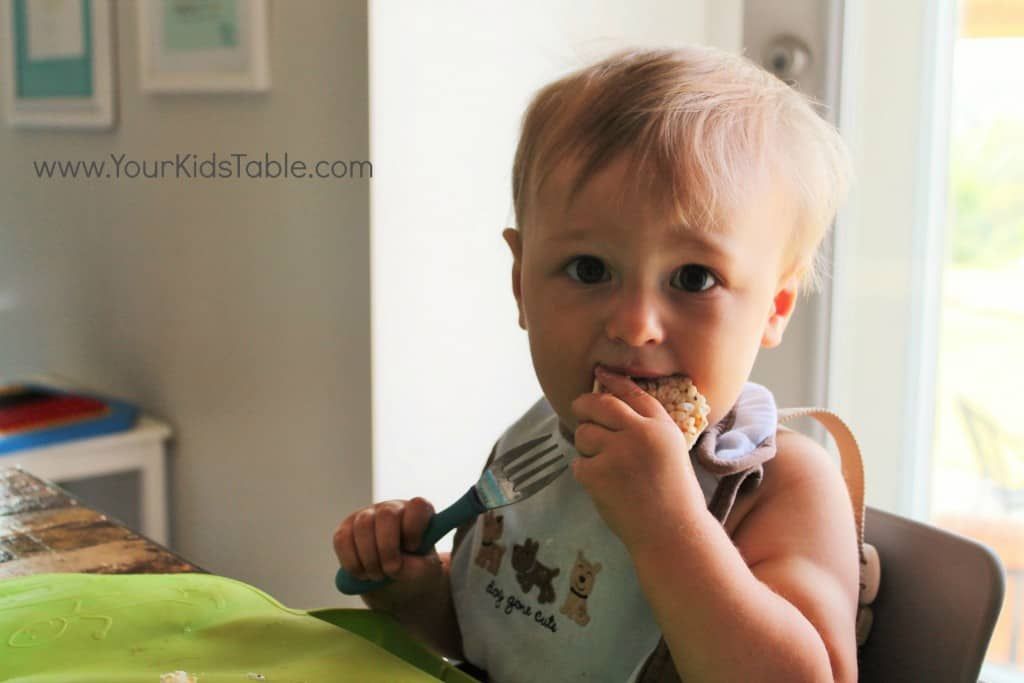 It is advisable to have someone else do this so that you can immediately begin to provide first aid.
It is advisable to have someone else do this so that you can immediately begin to provide first aid.
First aid for children under one year old
As a rule, infants choke while eating or drinking due to incorrect posture.
Your possible actions:
1. Raise the baby's hands up. Despite its unusualness and simplicity, this method helps to normalize the breathing process by expanding the airways.
2. Put the child on your hand with your stomach down and make five pats between the shoulder blades with the edge of your palm.
3. In the case when the baby choked on a small object, it is necessary by the child's legs so that the head is down and also pat between the shoulder blades
4. Tilt the body of the child down, press on the root of the tongue, thereby causing vomiting.
5. If the baby choked on the liquid and began to cough, choke with a cough, breathe noisily, and also in case of a solid object getting stuck, it is necessary to turn it with its back to you, hug your hand while pressing it on the stomach area, tilt the child forward and pat on the back, as described in the first paragraph.
If there are no signs of improvement, lay him on his back so that his head is lower than his torso. Place your middle and index fingers under your baby's breastbone. Do five pressures to a depth of 1-2 cm, making sure that after each of them the baby's sternum straightens without removing the fingers. You should alternate pressure and pats on the back until the doctors arrive. After each pop, check to see if the airway blockage has been cleared.
Attention! All pressing and patting should be gentle but sharp!
You can find on the Internet a recommendation to check the child's larynx with your finger and, if possible, remove the stuck object. Such advice is useful if the foreign object is something soft, such as cotton wool. In other cases, there is a great risk of aggravating the situation by accidentally moving the subject even further.
First aid for a child older than one year
Remain calm so as not to aggravate the child's panic.
You can use the above methods for older children as well. 5 point will differ by the posture of the child. See picture below:
Also for children aged from a year (in no case for children younger!) The Helmich method is effective. The sequence of your actions will be as follows:
- stand behind the baby, you can kneel if his height is still small
- clench the hand of one hand into a fist and place the thumb inside between the ribs and the navel of the child
- clasp the fist with the palm of the other hand
- spread your elbows to the sides and press on the child's stomach from the bottom up
- continue until the foreign object is out of the respiratory tract
If the child's breathing has stopped
If the child's breathing stops during removal of the foreign body and does not resume after removal, this may be the result of a spasm in the throat due to stress.








